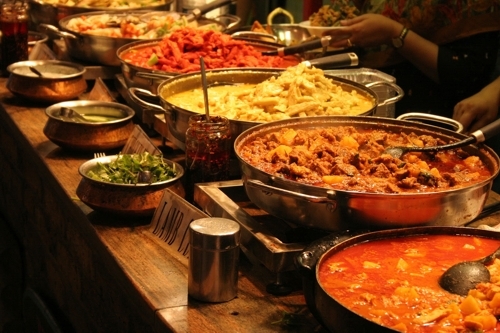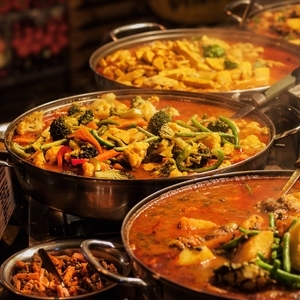If you thought that Indian (and other Asian) flavours were totally different from western ones, you were right! Now, Indian researchers have conducted an in-depth study of their traditional flavour pairings and discovered that India and the West are, indeed, 180 degrees apart in their fundamentals…
 Traditional Indian Buffet: Lots of spicy sauces, Lentils, Chicken and Lamb,
Traditional Indian Buffet: Lots of spicy sauces, Lentils, Chicken and Lamb,
and a plethora of veggie dishes. With more than 20 distinct regional cuisines,
Indian dining offers all but infinite possibilities!
I’ll bet you’ve always wondered why Indian (and other Asian) foods taste so different from the dishes we treasure as classic in the West. Indian researchers have now confirmed that there’s a scientific reason for the fundamental difference in the way the two cuisines affect your palate.
In the simplest of terms, they say, Indian recipes and food pairings lean toward combinations of ingredients whose chemical flavour components do not overlap with each other. This is called negative food pairing. North American, Western European and Latin American cuisines tend to have what the researchers call positive pairing, which means that foods with similar flavours and similar flavour-creating chemical components are more often used together.
Another interesting thing the study uncovered – but which was actually there all the time, for all to see – was that Asian recipes tend to have many more ingredients than Western recipes. The most visible expression of this tendency may be the Indian tradition of the Masala. Every Indian cook has their own Masala, or house spice blend. A Massala may have upwards of 20 constituent spices! The formulation of the Masala varies from region to region in India, and there are more than 20 distinct regional cuisines in that country! North Africa – another negative flavour pairing region – has its own version of Masala: Ras al Hanout, which literally means the the ‘House Blend’. Then there’s the tradition of blended Chili Pastes in Southeast Asia and the ancient institution of Chinese Five Spice Blend..
I’m not sure that knowing the scientific ins and outs of why Indian Food tastes so good will enhance or attenuate my enjoyment in the future. But I’m sure it will make me a better cook!
~ Maggie J.

